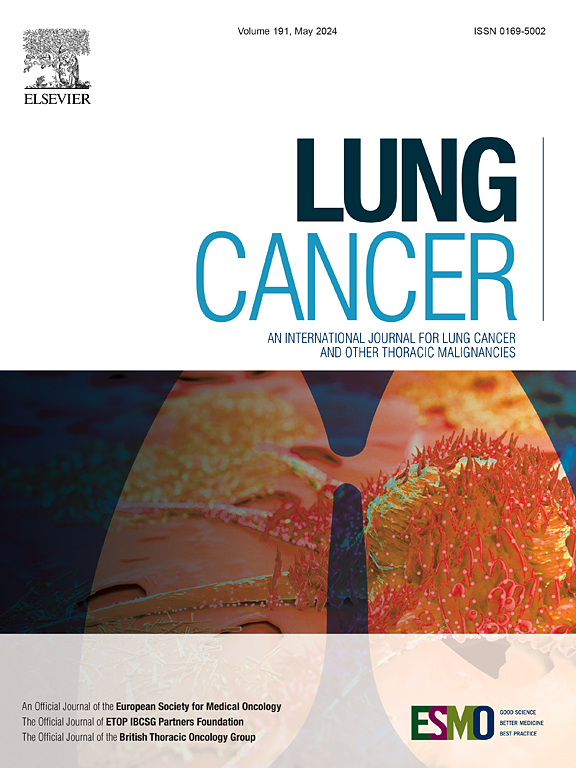Stereologic consequences of iatrogenic collapse: The morphology of adenocarcinoma in situ overlaps with invasive patterns. Proposal for a necessary modified classification of pulmonary adenocarcinomas
IF 4.5
2区 医学
Q1 ONCOLOGY
引用次数: 0
Abstract
Recognizing non-invasive growth patterns is necessary for correct diagnosis, invasive size determination and pT-stage in resected non-small cell lung carcinoma. Due to iatrogenic collapse after resection, the distinction between adenocarcinoma in-situ (AIS) and invasive adenocarcinoma may be difficult. The aim of this study is to investigate the complex morphology of non-mucinous non-invasive patterns of AIS in resection specimen with iatrogenic collapse, and to relate this to follow-up.
The effects of iatrogenic collapse on the morphology of collapsed AIS were simulated in a mathematical model. Three dimensional related criteria applied in a modified classification, using also cytokeratin 7 and elastin as additional stains, in two independent retrospective cohorts of primary pulmonary adenocarcinomas ≤3 cm resection specimen with available follow-up information.
The model demonstrated that infolding of alveolar walls occurs during iatrogenic collapse and lead to a significant increase in tumor cell heights in maximal collapse areas, compared to less collapsed areas. The morphology of infolded AIS overlaps with patterns described as papillary and acinar adenocarcinoma according to the WHO classification, necessitating an adaptation.
The modified classification incorporates recognition of iatrogenic and biologic collapse, tangential cutting effect true invasion and surrogate markers of invasion i.e. grey zone, covering a multilayering falling short of micropapillary, cribriform and solid alveolar filling growth. The use of elastin and CK7 staining aids in the morphologic recognition of iatrogenic collapsed AIS and the distinction from invasive adenocarcinoma. Out of a total of 70 resection specimens 1 case was originally classified as AIS and 9 were reclassified as iatrogenic collapsed AIS. Patients with collapsed AIS showed a 100 % recurrence-free survival after a mean follow-up time of 69.5 months.
With the current WHO classification, AIS is overdiagnosed as invasive adenocarcinoma due to infolding. The modified classification facilitates the diagnosis of AIS.
先天性塌陷的立体学后果:原位腺癌的形态与侵袭性腺癌的形态重叠。建议对肺腺癌进行必要的修改分类。
要对切除的非小细胞肺癌进行正确诊断、确定浸润性大小和 pT 分期,就必须识别非浸润性生长模式。由于切除术后的先天性塌陷,原位腺癌(AIS)和浸润性腺癌可能难以区分。本研究的目的是调查非黏液性非浸润性 AIS 在先天性塌陷切除标本中的复杂形态,并将其与随访联系起来。通过数学模型模拟了先天性塌陷对塌陷 AIS 形态的影响。在两个独立的具有随访信息的原发性肺腺癌≤3厘米切除标本回顾性队列中,将三维相关标准应用于修正的分类中,同时使用细胞角蛋白7和弹性蛋白作为附加染色。该模型表明,肺泡壁在先天性塌陷过程中会发生内折,与塌陷程度较轻的区域相比,最大塌陷区域的肿瘤细胞高度会显著增加。内折 AIS 的形态与世卫组织分类中描述的乳头状腺癌和尖状腺癌的形态重叠,因此有必要进行调整。修改后的分类纳入了对先天性和生物性塌陷的认识、切向切割效应的真正侵袭和侵袭的替代标志物(即灰区),涵盖了微乳头状、楔形和实性肺泡填充生长的多层次缺失。使用弹性蛋白和 CK7 染色有助于从形态学上识别先天性塌陷性 AIS,并与浸润性腺癌相鉴别。在总共 70 例切除标本中,1 例最初被归类为 AIS,9 例被重新归类为先天性塌陷性 AIS。在平均 69.5 个月的随访时间后,塌陷型 AIS 患者的无复发生存率达到了 100%。按照目前的世卫组织分类法,AIS会因折叠而被过度诊断为浸润性腺癌。修改后的分类有助于 AIS 的诊断。
本文章由计算机程序翻译,如有差异,请以英文原文为准。
求助全文
约1分钟内获得全文
求助全文
来源期刊

Lung Cancer
医学-呼吸系统
CiteScore
9.40
自引率
3.80%
发文量
407
审稿时长
25 days
期刊介绍:
Lung Cancer is an international publication covering the clinical, translational and basic science of malignancies of the lung and chest region.Original research articles, early reports, review articles, editorials and correspondence covering the prevention, epidemiology and etiology, basic biology, pathology, clinical assessment, surgery, chemotherapy, radiotherapy, combined treatment modalities, other treatment modalities and outcomes of lung cancer are welcome.
 求助内容:
求助内容: 应助结果提醒方式:
应助结果提醒方式:


